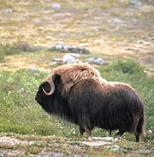|
 Arctic
Tundra: Animals Arctic
Tundra: Animals
Not many kinds
of animals live year-round in the Arctic tundra. Most birds and
mammals only use the tundra as a summer home. Mammals that do live
year-round in the tundra include the muskox, Arctic wolf, and brown
bear; and each has its own way of adapting to the extreme climatic
conditions. Animals need to find ways to stay warm and to provide
nourishment for themselves in order to survive the long, cold, winter
months.
Animal adaptations
Migration and hibernation are examples of behavioral adaptations
used by animals in the Arctic tundra. The fact that many animals
do not live year-round in the tundra means they leave or migrate
for a length of time to warmer climates.
Hibernation is a combination
of behavioral and physical adaptations. For example, during the
summer the brown bear's behavior is to eat just about anything it
can find; then it hibernates, or sleeps, during the winter. The
bear's physical adaptation allows the food eaten during the summer
to be stored as a layer of fat underneath its skin. The layer of
fat insulates the bear from the cold. While in hibernation the fat
is slowly converted into energy that maintains life.
 A
physical adaptation used by the Musk Ox is the growth of two layers
of fur--one short and the other long. Air is trapped in the short
layer of fur and is warmed by body heat. The warmed air, trapped
close to the body, acts as insulation from the cold. The layer of
long fur protects the Musk Ox from the wind and water. In addition
to thick layers of fur, the Musk Ox relies on another physical adaptation
to help it survive. The hooves of the Musk Ox are large and hard.
During the winter months, this adaptation allows the Musk Ox to
break the ice and drink the water underneath. Photos
© 2000-www.arttoday.com A
physical adaptation used by the Musk Ox is the growth of two layers
of fur--one short and the other long. Air is trapped in the short
layer of fur and is warmed by body heat. The warmed air, trapped
close to the body, acts as insulation from the cold. The layer of
long fur protects the Musk Ox from the wind and water. In addition
to thick layers of fur, the Musk Ox relies on another physical adaptation
to help it survive. The hooves of the Musk Ox are large and hard.
During the winter months, this adaptation allows the Musk Ox to
break the ice and drink the water underneath. Photos
© 2000-www.arttoday.com
Back
| Next
|











